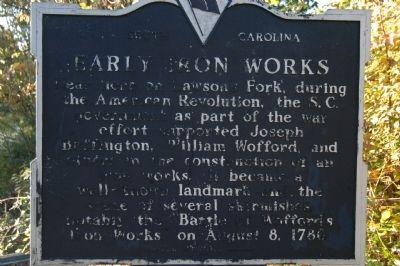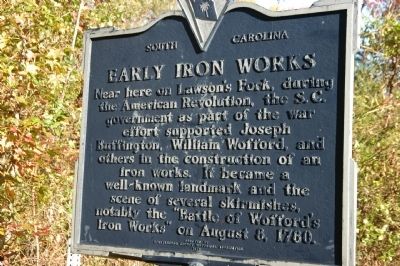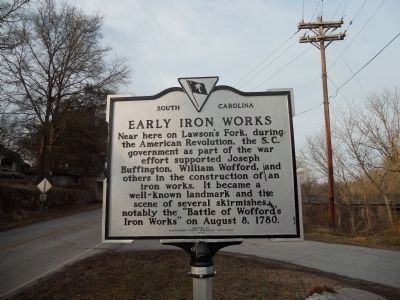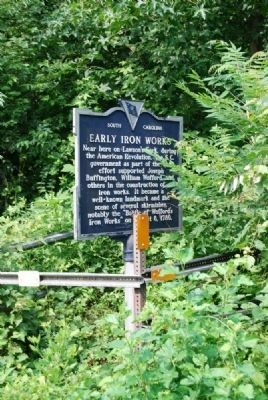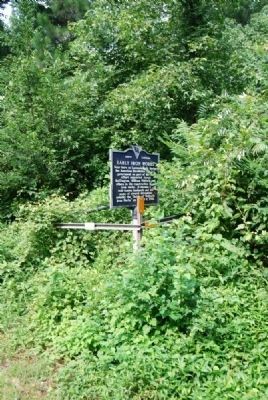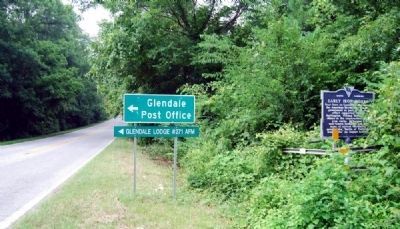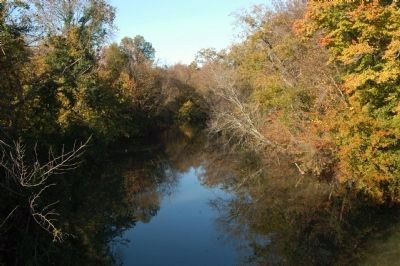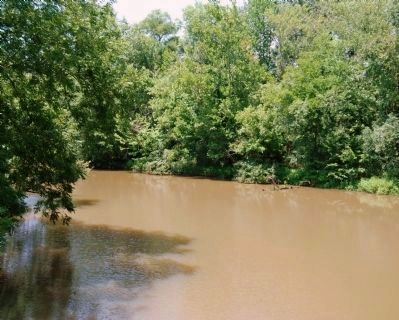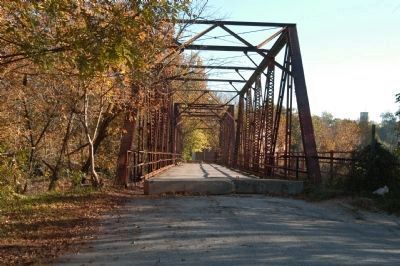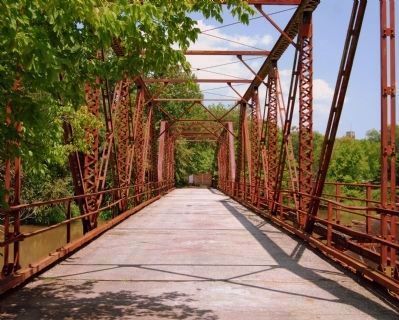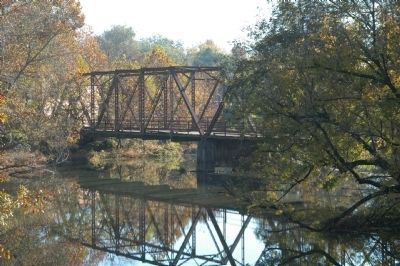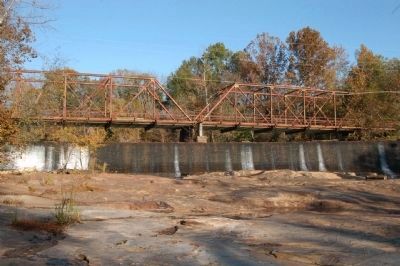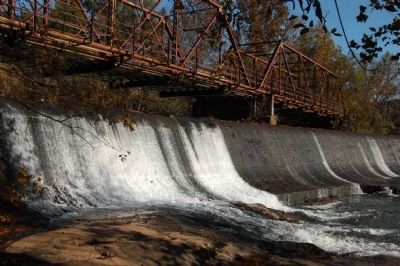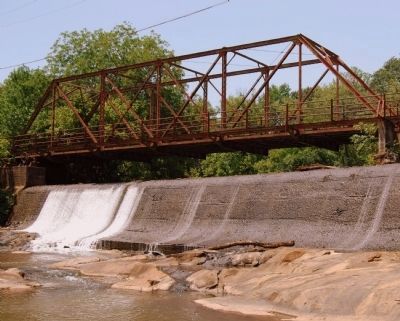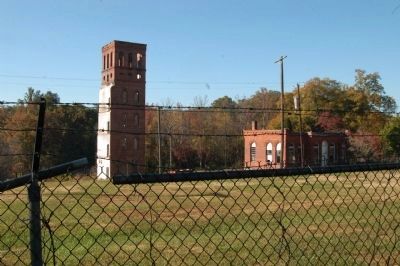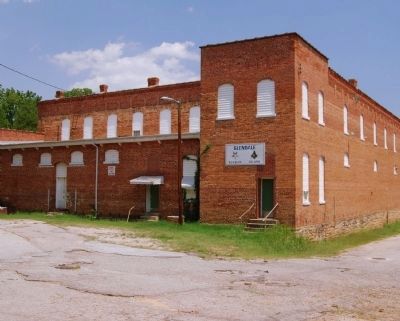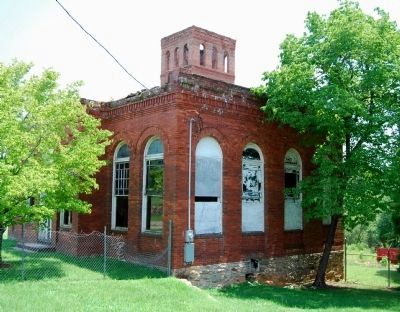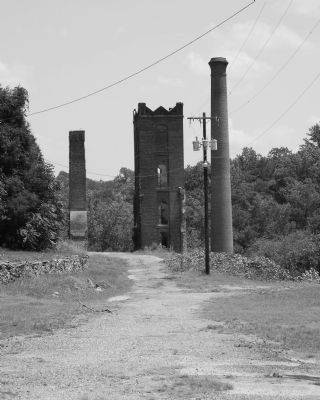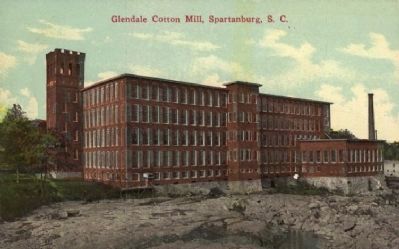Glendale in Spartanburg County, South Carolina — The American South (South Atlantic)
Early Iron Works
Near here on Lawson's Fork, during the American Revolution, the S.C. government as part of the war effort supported Joseph Buffington, William Wofford, and others in the construction of an iron works. It became a well-known landmark and the scene of several skirmishes, notably the "Battle of Wofford's Iron Works" on August 8, 1780.
Erected 1979 by Spartanburg County Historical Association. (Marker Number 42-10.)
Topics. This historical marker is listed in these topic lists: Industry & Commerce • War, US Revolutionary. A significant historical year for this entry is 1780.
Location. Marker has been reported missing. It was located near 34° 56.632′ N, 81° 50.397′ W. Marker was in Glendale, South Carolina, in Spartanburg County. Marker was at the intersection of Clifton-Glendale Road and Glendale Avenue, on the left when traveling north on Clifton-Glendale Road. Touch for map. Marker was in this post office area: Glendale SC 29346, United States of America. Touch for directions.
Other nearby markers. At least 10 other markers are within 4 miles of this location, measured as the crow flies. Welcome to Glendale Shoals (approx. 0.2 miles away); Camp Croft (approx. 1.8 miles away); Battle of Cedar Spring (approx. 3.1 miles away); Clifton Baptist Church / First Baptist Church (approx. 3.2 miles away); Clifton World War II Memorial (approx. 3.2 miles away); Pacolet River Heritage Preserve (approx. 3˝ miles away); The Pacolet River Flood of 1903 (approx. 3˝ miles away); American Legion Memorial Archway (approx. 4 miles away); Spartanburg County War Memorial (approx. 4 miles away); Purple Heart Memorial (approx. 4 miles away).
Regarding Early Iron Works. The Battle of Wofford's Iron Works is sometimes referred to as the Second Battle of Cedar Springs. It was a running engagement. On the morning of August 8th, patriot scouts bought word of approaching enemy troops. The patriots broke camp and fell back to an advantageous position near the old iron works. A detachment of British dragoons and mounted militia from Major Patrick Ferguson's command under Major James Dunlap attacked the patriot position. The first attack was repulsed but, Dunlap rallied his troops for a second attack. Hand-to-hand fighting ensued but, the British forces were driven back. Dunlap's forces were chased for a short period before the patriots regrouped at their position. Dunlap met up with Major Ferguson's force and advanced on the patriot position again. The outnumbered
patriots performed a fighting retreat until they crossed the Pacolet river near present day Clifton and Ferguson was forced to break off pursuit.
The iron works were erected near this site in 1773 by Joseph Buffington. Due to finances and a land title dispute the iron works came to be owned by William Wofford whom is a relative of the founder of nearby Wofford College. In 1778 Wofford sold the iron works to Simon and John Berwick and Charles Elliot. It was sold again in 1785 to William Poole. The area gave rise to a local iron industry which did not end until after the Civil War. In fact, the furnaces at Glendale made supplies and equipment for the Confederate war effort. Today, the iron works are gone and Glendale is remembered more for the textile industry.
Also see . . .
1. Welcome to Glendale. Website homepage (Submitted on November 2, 2008, by Brian Scott of Anderson, South Carolina.)
2. The Revolutionary War Battle of Wofford's Iron Works. Glendale website entry (Submitted on November 2, 2008, by Craig Swain of Leesburg, Virginia.)
3. Collection of Photos of the Glendale Mill Fire. Glendale website entry (Submitted on November 2, 2008, by Brian Scott of Anderson, South Carolina.)
4. Bivings-Converse House. South Carolina Department of Archives and History website entry:
The Bivings-Converse House, built ca. 1836, is significant as an excellent
vernacular example of mid-nineteenth century Roman Revival (or Greek Revival) residential architecture with late-nineteenth century alterations and for its association with Dr. James Bivings (1781-1869), prominent local textile pioneer, and Dexter Edgar Converse (1829-1899), industrialist, textile entrepreneur, and founder of Converse College. (Submitted on November 2, 2008, by Brian Scott of Anderson, South Carolina.)
5. The History of the Glendale Mill as Told by People in the Glendale Community. (Submitted on November 2, 2008, by Brian Scott of Anderson, South Carolina.)
Additional commentary.
1. Marker Style
The marker shown reflects the second style of South Carolina Historical Markers. It was in use between 1955 and 1990. The original design was cast aluminum and crowned with a bas relief of the state flag surrounded by an inverted triangle. The markers were painted dark blue with silver lettering.
— Submitted November 2, 2008, by Brian Scott of Anderson, South Carolina.
2. The Battle of What ?
"Also known as 2nd Cedar Springs, Berwick's Iron Works, Green Springs, Buffington's Iron Works or the Peach Orchard. This action has many different versions, depending on the source. One course states that Ferguson and Dunlap had 2,500 men, and lost a hundred men. Another source writes that Dunlap was not there, but Colonel Innes was. The location is different in each source. It happens in a peach orchard, or in an old iron works, or in a small town. The date is different, depending on the source. Haywood wrote that it was on August 1st; McCall wrote it was August 10th; McClain says it was August 8th. even the time of day is disputed in the different versions. Depending on the source it either happened at the dark of night, the early morning twilight, or in the afternoon. This confusion is typical of the backwoods encounters between the British and the frontiersmen." (Source: Nothing But Blood and Slaughter: The Revolutionary War in the Carolinas, Volume II: 1780, Patrick O'Kelley (2004) p. 529-530.)
— Submitted November 2, 2008, by Brian Scott of Anderson, South Carolina.
3. "Mill goes up in flames", Spartanburg Herald-Journal
Mill goes up in flames
By Susan Orr | And JANET S. SPENCER
Glendale -- Fourteen-year-old Zach Ivey knelt in the street and put the palms of his hands down, leveling his back Saturday afternoon so his friend, Dustin Roberts, could use it as a platform to photograph the still-smoldering Glendale Mill.
Roberts, 15, snapped a few shots as thick smoke continued to roll from the ruins 15 hours after a fire left only the brick wall outline of the 137-year-old, five-story structure.
"This place is historical," Ivey said when Roberts jumped from his back. "We studied about it in school."
Working their way back up the street, the teens pulled a shiny, red Radio Flyer wagon they had hoped to use for a better vantage point. But when the authorities would not let them take it in, Ivey gave Roberts the boost he needed for the photography session.
"We've been around here watching since 3 a.m.," said Roberts, a student at Broome High School. "At first, we thought it was our friend's house. We came running down here to be sure he was alright."
The teens were wide-eyed as they talked about the blaze that gutted the mill, which closed 43 years ago.
"It was terrible. Those flames were just so high," Ivey said, throwing his head back and looking into the sky.
They stood in front of a house facing the mill that was the only other structure damaged by the roaring early morning blaze that sent red and yellow flames high into the air, said Glendale Assistant Fire Chief Eric Alley.
Alley said he was on duty at the station just down the street when the call to 911 came in at 2:26 a.m. Saturday.
In addition to numerous rows of houses, which had to be protected from the heat and blaze, the Post Office is adjacent to the property and its operation was shut down for the day. Also within a half-mile radius of the mill are the Spartanburg County District 3 school administrative offices and at least five churches.
More than 80 firefighters from the Glendale, Pacolet, Converse and Drayton departments responded and rotated working throughout the day trying to extinguish the blaze and prevent it from spreading.
A crew of firefighters was assigned to remain overnight to keep the blaze from rekindling. Agents with the State Law Enforcement Division called to the scene to determine the cause waited for what was left to cool so they could begin their work.
"When I pulled in, the back part of the mill – the three-story section -- was fully engulfed in flames," Alley said. "It's a total loss. Everything's gone, except a small newer office addition here closest to the post office," Alley said. "Right now we're just working to keep the hot spots down."
Anderson-based Glendale Development Corp. owned the 250,000-square-foot mill. Several companies were leasing space for storage, according to Glendale Development President Mike Cicora.
Cicora, whose group bought the mill in 2000, said he learned about the fire when a friend called him Saturday morning
after seeing a report on television.
He said there were plans to redevelop the mill, possibly turning it into condominiums. "It may have looked like there was nothing happening, but we had strong interest from several different groups," Cicora said. "There were no immediate plans, but certainly there were plans for developing the property. I'm absolutely devastated by this. Three and a half years of my life literally went up in smoke."
The mill was built about 1867, and the site along Lawson's Fork Creek has an even richer history. It was first developed in 1773, when Joseph Buffington built Buffington Iron Works. But Buffington struggled and eventually lost the facility to William Wofford in a land dispute.
During the Revolutionary War, British soldiers ambushed American forces that had camped out at Wofford's Iron Works on Aug. 7, 1780. The Americans fought off their attackers and the foundry was spared.
A year later, the iron works was destroyed in a raid led by "Bloody" Bill Cunningham. But it reopened after the war as South Carolina Iron works. James Bivings of Lincolnton, N.C., bought the property and built the Bivingsville Cotton Factory in the early 1830s. It was South Carolina's first cotton mill with more than 1,000 spindles.
The mill went bankrupt in 1855, and Bivings sold it to John Bomar and Co. for $19,500 a year later. Bomar's group hired Edgar Converse to run the operation. The mill flourished under Converse, and during the Civil War a third of the plant's production went to the Confederate government.
The factory was razed after the war and a new mill – the one that burned Saturday morning -- was built around 1867. The company also had a new name – D.E. Converse and Co. The name of the mill was changed to Glendale in 1878. Another section was added in 1890, and another expansion occurred in 1902. By 1907 it had more than 37,000 spindles.
Stifel and Sons of Wheeling, W.Va., bought the mill in 1946. Stifel remodeled the mill village homes and sold them to the employees in 1955. Indian Head Mills bought the facility in 1957. Four years later, the looms stopped running for good.
Neighbors and motorists following the smoke continued to gather and watch the activity of firefighters throughout the day. Several people reported hearing large booms that awakened them.
Witnesses said it took firefighters two or three hours to get the blaze under control, and as late as noon an isolated patch of fire could still be seen amid the rubble.
Ray Price, a firefighter and photographer for the Glendale Fire Department, said the mill's size and condition made this the worst fire he had ever seen in his 30 years of photographing fires for documentation and
training purposes. Many people walked around surveying the scene and documenting the mill's demise by shooting photos and video images.
Broadway Street resident Tim Williams learned of the fire at 2:35 a.m. when a neighbor called him. He soon got an up-close look at the blaze when he helped a friend move a dump truck and other vehicles the friend had stored behind the mill.
Driving on an access road behind the mill, Williams saw burning embers falling through the air and bricks flying out of windows.
"It looked like volcano rocks falling down," Williams said. "I had my (vehicle) windows up and my air conditioner on and it was burning my face, it was so hot." But Williams said the only damage to his vehicle was some soot marks.
Donald Hughes, another Broadway Street resident, lives a block or so from the mill and he said the flames were so intense that they lit up the darkness.
"I live on the top of the hill and when I walked outside it was like broad daylight," Hughes said. Hughes believes that if the wind had not shifted and blown flames away from the mill village that many mill houses would have succumbed to the blaze.
The fire was especially threatening to Hughes' mother, Dee Bryant, who lives on Glendale Avenue right across from the mill.
She woke up around 2 a.m. when she heard a loud explosion, and when she looked
outside she saw towers of flames. "I was freaking out," Bryant said.
Once the fire spread to the part of the mill closest to her home, the heat was so intense that it began to melt her vinyl siding.
Neighbors tried to wet her home with a garden hose, but the water pressure was too low so Drayton's fire department had to come and spray Bryant's house in order to save it. "Thank goodness for Drayton," she said.
John Bishop of Duncan Street, a lifelong Glendale resident who worked at the mill as a teenager, said he was sorry to see the mill gone because of its history. "It went down in a hurry," Bishop said. "In about two or three hours, it was down."
— Submitted November 2, 2008, by Brian Scott of Anderson, South Carolina.
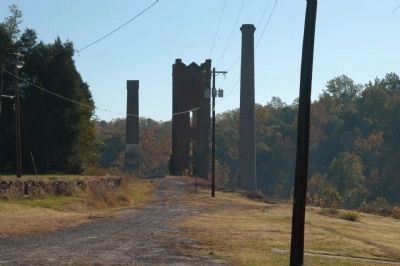
Photographed By Michael Sean Nix, November 1, 2008
15. Remains of the old Glendale Mill
The mill burned down in 2004. Only a few smokestacks, towers, and a building remain. Like the old iron works, the mill was founded on the banks of Lawson's Fork because it provided power to the mill in the form of a water wheel. The mill was founded in the 1830's by James Bivings. County records show he bought many tracts of land in the area including the site of the old iron works. In 1856, it was bought by Dexter Converse whom founded nearby Converse College.
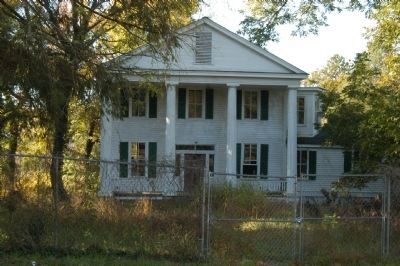
Photographed By Michael Sean Nix, November 1, 2008
21. Bivings-Converse House
The Bivings-Converse house was built in 1836 and is an example of Greek Revival architecture. It was built by James Bivings whom founded the Glendale textile mill in 1831 (originally named the Bivingsville Cotton Factory). The house later came into the possesion of Dexter Converse. The structure is currently vacant and is in need of much restoration. It is listed on the National Historic Register.
Credits. This page was last revised on December 14, 2021. It was originally submitted on November 1, 2008, by Michael Sean Nix of Spartanburg, South Carolina. This page has been viewed 4,605 times since then and 59 times this year. Photos: 1, 2. submitted on November 1, 2008, by Michael Sean Nix of Spartanburg, South Carolina. 3. submitted on February 22, 2014, by Darrell Bruggeman of Whitmire, South Carolina. 4, 5, 6. submitted on July 11, 2011, by Brian Scott of Anderson, South Carolina. 7. submitted on November 1, 2008, by Michael Sean Nix of Spartanburg, South Carolina. 8. submitted on November 2, 2008, by Brian Scott of Anderson, South Carolina. 9. submitted on November 1, 2008, by Michael Sean Nix of Spartanburg, South Carolina. 10. submitted on November 2, 2008, by Brian Scott of Anderson, South Carolina. 11, 12, 13. submitted on November 1, 2008, by Michael Sean Nix of Spartanburg, South Carolina. 14. submitted on November 2, 2008, by Brian Scott of Anderson, South Carolina. 15, 16. submitted on November 1, 2008, by Michael Sean Nix of Spartanburg, South Carolina. 17, 18, 19, 20. submitted on November 2, 2008, by Brian Scott of Anderson, South Carolina. 21. submitted on November 1, 2008, by Michael Sean Nix of Spartanburg, South Carolina. • Craig Swain was the editor who published this page.
